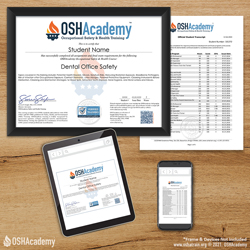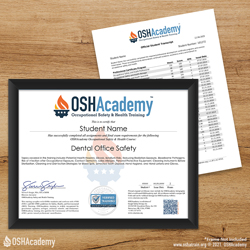Introduction
Dental professionals may be at risk for exposure to numerous workplace hazards. These hazards include, but are not limited to, the spectrum of bloodborne pathogens, pharmaceuticals and other chemical agents, human factors, ergonomic hazards, noise, vibration, and workplace violence.
There are currently no specific Occupational Health and Safety Administration (OSHA) standards for dentistry. However, exposure to numerous biological, chemical, environmental, physical, and psychological workplace hazards that may apply to dentistry are addressed in specific standards for the general industry.
This course is designed to help provide a solid foundation for employees working in dental offices. It will look at the potential health risks of working in a dental setting and ways you, as an employee, can protect yourself and other co-workers from potential health problems. The course will also discuss ways to properly clean and sanitize common machinery in a dental laboratory.
Course Objectives
| ID | Objective |
|---|---|
| TO 1.0 | Achieve a minimum score of 70% on the final course assessment. |
| LO 1.1.1 | Describe the potential health hazards to which dental employees may be exposed. |
| LO 1.1.2 | Describe the risks of exposure and symptoms of silicosis and beryllium. |
| LO 1.1.3 | List and describe the three strategies for controlling exposure to beryllium and other hazardous substances. |
| LO 1.1.4 | Describe the risk and controls for exposure to ionizing radiation (x-rays). |
| LO 1.1.5 | Describe procedures within the bloodborne Exposure Control Plan. |
| LO 1.1.6 | Discuss the risk and controls for exposure to latex. |
| LO 1.2.1 | Describe the different types of personal protective equipment used by dental clinic employees. |
| LO 1.2.2 | Describe dental equipment cleaning, disinfecting, sterilization and storage procedures. |
| LO 1.2.3 | Describe good housekeeping practices for dental clinics. |
| LO 1.2.4 | Describe procedures for hand care and hygiene |
Key: Terminal Objective (TO), Learning Objective (LO)



